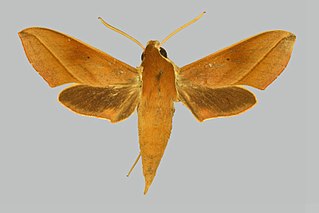
Hippotion batschii is a moth of the family Sphingidae. It is known from Madagascar.
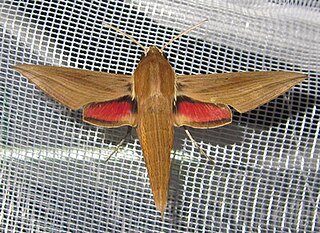
Hippotion eson is a moth of the family Sphingidae. It is very common in most habitats throughout the Ethiopian Region, including Madagascar and the Seychelles. It is a migratory species.

Hippotion griveaudi is a moth of the family Sphingidae. It is known from Madagascar.
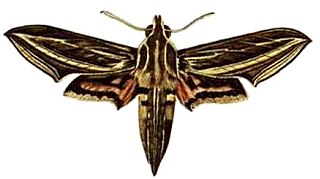
Hippotion osiris is a moth of the family Sphingidae. It is common throughout most of the Ethiopian Region, including Madagascar and the Seychelles. Occasional vagrants have been recorded from Spain. It is uncommon on the East African coast. This species is an occasional migrant.
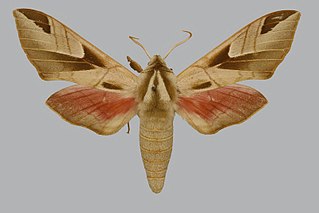
Leptoclanis is a genus of moths in the family Sphingidae, containing one species Leptoclanis pulchra, it is known from Brachystegia woodland from Angola and Zimbabwe to Zambia, the Democratic Republic of the Congo and southern Tanzania.
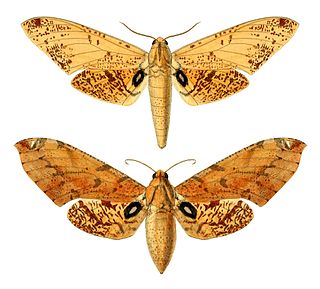
Platysphinx stigmatica is a moth of the family Sphingidae. It is known from forests from Nigeria to the Congo, Angola and western Uganda.

Basiothia medea, the small verdant hawk, is a moth of the family Sphingidae. It is common in open habitats throughout the Ethiopian Region, including Madagascar. It is however probably absent from the equatorial forest belt, except as a vagrant. The species is an active migrant.

Neopolyptychus pygarga is a moth of the family Sphingidae. It is known from forests in western Africa, including Cameroon and Nigeria.
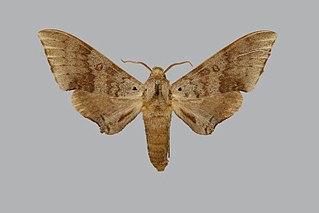
Neopolyptychus prionites is a moth of the family Sphingidae. It is known from lowland forests and heavy woodland from Guinea to the Congo and western Uganda.

Phylloxiphia punctum is a moth of the family Sphingidae. It is known from savanna from north-eastern South Africa to Zimbabwe, Zambia, the Democratic Republic of the Congo and Tanzania.
Phylloxiphia goodii is a moth of the family Sphingidae. It is known from Sierra Leone, Liberia, Cameroon, the Central African Republic, Gabon, the Democratic Republic of the Congo and the Republic of the Congo.

Phylloxiphia oberthueri is a moth of the family Sphingidae. It is known from lowland forests from Liberia and Ivory Coast east to the Democratic Republic of the Congo.
Phylloxiphia formosa is a moth of the family Sphingidae. It is found from Sierra Leone, Liberia and Ivory Coast to the Central African Republic, Uganda and Tanzania, south to Zambia.
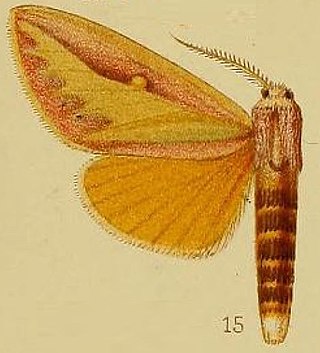
Leucophlebia afra is a moth of the family Sphingidae. It is found from Senegal to northern Uganda and Sudan in the east, and to Angola in the west.

Praedora leucophaea is a moth of the family Sphingidae. It is known from dry bush areas from northern South Africa to Kenya.

Sphingonaepiopsis ansorgei is a moth of the family Sphingidae. It is known from open habitats from northern South Africa to East Africa in the east and to Angola in the west.

Temnora spiritus is a moth of the family Sphingidae. It is known from forests from Sierra Leone to Congo, Uganda, and western Kenya.
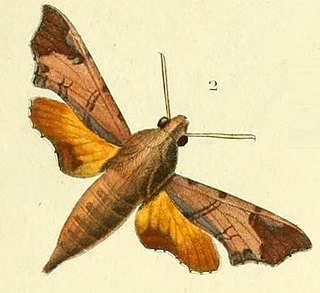
Temnora pseudopylas is a moth of the family Sphingidae. It is very common in eastern and southern Africa, but absent in very dry habitats.

Nephele peneus is a moth of the family Sphingidae. It is known from forests and woodland from Senegal to East Africa, Angola and Delagoa Bay.

Theretra monteironis is a moth of the family Sphingidae. It is known from dry habitats from KwaZulu-Natal to eastern Kenya.















